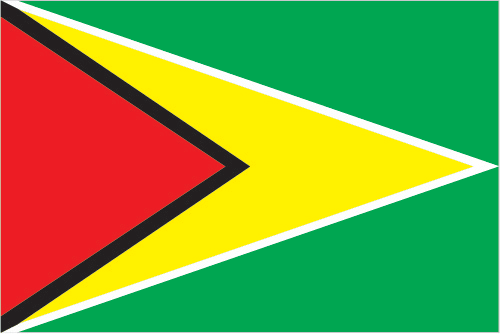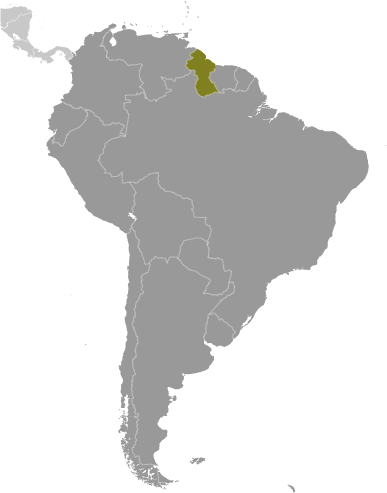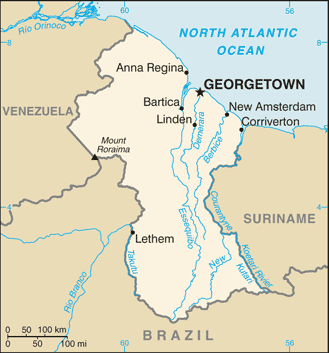|
Economy - overview:
|

|
|
The Guyanese economy exhibited moderate economic growth in recent years and is based largely on agriculture and extractive industries. The economy is heavily dependent upon the export of six commodities - sugar, gold, bauxite, shrimp, timber, and rice - which represent nearly 60% of the country's GDP and are highly susceptible to adverse weather conditions and fluctuations in commodity prices. Guyana's entrance into the Caricom Single Market and Economy (CSME) in January 2006 has broadened the country's export market, primarily in the raw materials sector. Guyana has experienced positive growth almost every year over the past decade. Inflation has been kept under control. Recent years have seen the government's stock of debt reduced significantly - with external debt now less than half of what it was in the early 1990s. Chronic problems include a shortage of skilled labor and a deficient infrastructure. Despite recent improvements, the government is still juggling a sizable external debt against the urgent need for expanded public investment. In March 2007, the Inter-American Development Bank, Guyana's principal donor, canceled Guyana's nearly $470 million debt, equivalent to 21% of GDP, which along with other Highly Indebted Poor Country (HIPC) debt forgiveness brought the debt-to-GDP ratio down from 183% in 2006 to 120% in 2007. Guyana became heavily indebted as a result of the inward-looking, state-led development model pursued in the 1970s and 1980s. Growth slowed in 2009 as a result of the world recession, but picked up in 2010-11, before slowing again in 2012, as a result of a second recession, this focused mainly in Europe. The slowdown in the domestic economy and lower import costs has helped to narrow the country's current account deficit, despite generally lower earnings from exports.
|
|
|
GDP (purchasing power parity):
|

|
|
$6.164 billion (2012 est.)
country comparison to the world: 163
$5.946 billion (2011 est.)
$5.639 billion (2010 est.)
note:
data are in 2012 US dollars
|
|
|
GDP (official exchange rate):
|

|
|
$2.788 billion (2012 est.)
|
|
|
GDP - real growth rate:
|

|
|
3.7% (2012 est.)
country comparison to the world: 95
5.4% (2011 est.)
4.4% (2010 est.)
|
|
|
GDP - per capita (PPP):
|

|
|
$8,000 (2012 est.)
country comparison to the world: 132
$7,700 (2011 est.)
$7,300 (2010 est.)
note:
data are in 2012 US dollars
|
|
|
GDP - composition by sector:
|

|
|
agriculture: 20.3%
industry:
34.8%
services:
44.9% (2012 est.)
|
|
|
Labor force:
|

|
|
313,100 (2009 est.)
country comparison to the world: 164
|
|
|
Labor force - by occupation:
|

|
|
agriculture: NA%
industry:
NA%
services:
NA%
|
|
|
Unemployment rate:
|

|
|
11% (2007)
country comparison to the world: 118
|
|
|
Population below poverty line:
|

|
|
35% (2006)
|
|
|
Household income or consumption by percentage share:
|

|
|
lowest 10%: 1.3%
highest 10%:
33.8% (1999)
|
|
|
Distribution of family income - Gini index:
|

|
|
44.6 (2007)
country comparison to the world: 44
43.2 (1999)
|
|
|
Investment (gross fixed):
|

|
|
29.6% of GDP (2012 est.)
country comparison to the world: 23
|
|
|
Budget:
|

|
|
revenues: $628.7 million
expenditures:
$793.1 million (2012 est.)
|
|
|
Taxes and other revenues:
|

|
|
22.5% of GDP (2012 est.)
country comparison to the world: 136
|
|
|
Budget surplus (+) or deficit (-):
|

|
|
-5.9% of GDP (2012 est.)
country comparison to the world: 171
|
|
|
Public debt:
|

|
|
66.1% of GDP (2012 est.)
country comparison to the world: 41
62.1% of GDP (2011 est.)
|
|
|
Inflation rate (consumer prices):
|

|
|
3.1% (2012 est.)
country comparison to the world: 80
2.6% (2011 est.)
|
|
|
Central bank discount rate:
|

|
|
5.5% (31 December 2011 est.)
country comparison to the world: 83
4.25% (31 December 2010 est.)
|
|
|
Commercial bank prime lending rate:
|

|
|
13.9% (31 December 2012 est.)
country comparison to the world: 52
14.45% (31 December 2011 est.)
|
|
|
Stock of narrow money:
|

|
|
$462.4 million (31 December 2012 est.)
country comparison to the world: 159
$435.1 million (31 December 2011 est.)
|
|
|
Stock of broad money:
|

|
|
$1.696 billion (31 December 2011 est.)
country comparison to the world: 154
$1.499 billion (31 December 2010 est.)
|
|
|
Stock of domestic credit:
|

|
|
$1.097 billion (31 December 2012 est.)
country comparison to the world: 156
$1.014 billion (31 December 2011 est.)
|
|
|
Market value of publicly traded shares:
|

|
|
$440.4 million (31 December 2011)
country comparison to the world: 111
$339.8 million (31 December 2010)
$287 million (31 December 2009)
|
|
|
Agriculture - products:
|

|
|
sugarcane, rice, edible oils; beef, pork, poultry; shrimp, fish
|
|
|
Industries:
|

|
|
bauxite, sugar, rice milling, timber, textiles, gold mining
|
|
|
Industrial production growth rate:
|

|
|
0.3% (2010)
country comparison to the world: 140
|
|
|
Current account balance:
|

|
|
-$324.8 million (2012 est.)
country comparison to the world: 86
-$307.2 million (2011 est.)
|
|
|
Exports:
|

|
|
$1.229 billion (2012 est.)
country comparison to the world: 153
$1.18 billion (2011 est.)
|
|
|
Exports - commodities:
|

|
|
sugar, gold, bauxite, alumina, rice, shrimp, molasses, rum, timber
|
|
|
Exports - partners:
|

|
|
Canada 29%, US 28.6%, UK 4.9%, Trinidad and Tobago 4.3%, Jamaica 4.3%, Netherlands 4% (2011)
|
|
|
Imports:
|

|
|
$1.85 billion (2012 est.)
country comparison to the world: 165
$1.746 billion (2011 est.)
|
|
|
Imports - commodities:
|

|
|
manufactures, machinery, petroleum, food
|
|
|
Imports - partners:
|

|
|
US 21.3%, Trinidad and Tobago 20%, China 8.3%, South Africa 7.5%, Cuba 5.5% (2011)
|
|
|
Reserves of foreign exchange and gold:
|

|
|
$1.002 billion (31 December 2012 est.)
country comparison to the world: 138
$801.8 million (31 December 2011 est.)
|
|
|
Debt - external:
|

|
|
$1.234 billion (31 December 2010)
country comparison to the world: 150
$804.3 million (30 September 2008)
|
|
|
Exchange rates:
|

|
|
Guyanese dollars (GYD) per US dollar -
204.4 (2012 est.)
204.02 (2011 est.)
203.64 (2010 est.)
203.95 (2009)
203.86 (2008)
|
|
|
Fiscal year:
|

|
|
calendar year
|
|
|
|





 )
)



